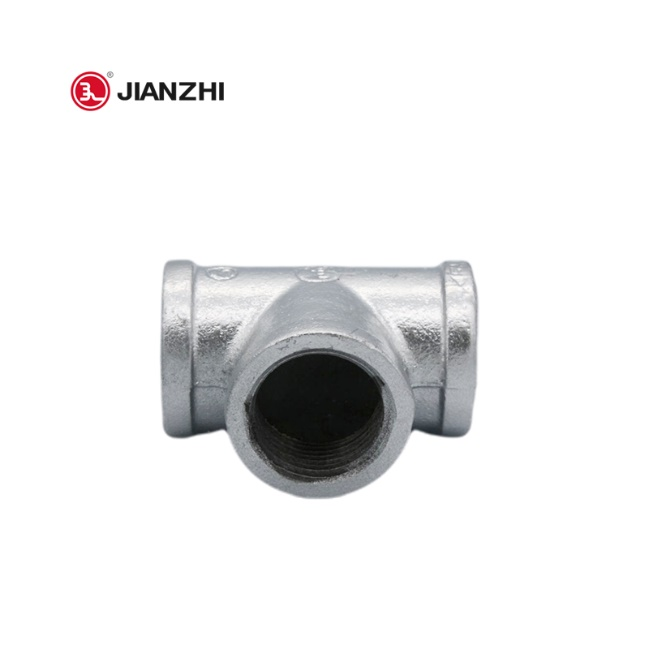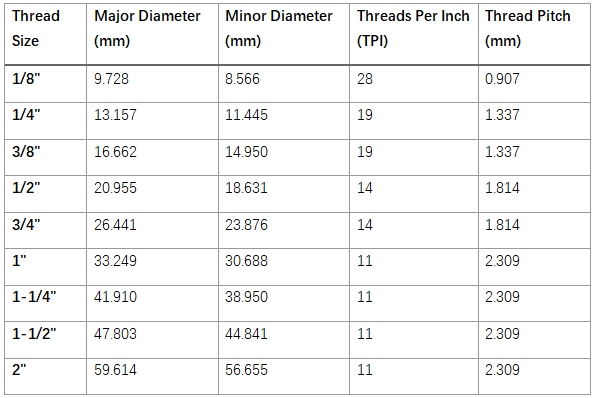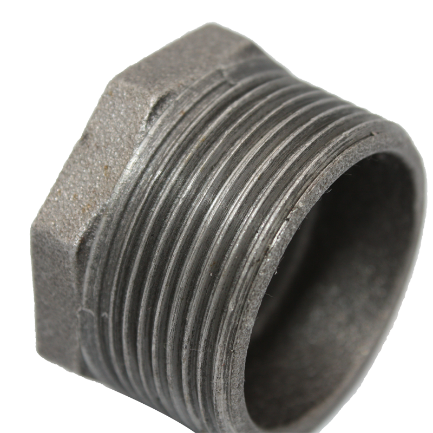Oct. 17, 2025
Bspp (British Standard Pipe Parallel) thread is a widely used thread standard in the mechanical and plumbing industries. It is part of the BSP (British Standard Pipe) family, specifically designed for use in non-tapered fittings. The Bspp thread standard is highly versatile and often applied in low-pressure systems such as water, air, and gas lines.
Understanding BSPP (British Standard Parallel Pipe) thread dimensions is critical for ensuring leak-tight seals in hydraulic and pneumatic systems. For Brazilian engineers and procurement specialists dealing with international standards, getting the precise measurements can be the difference between a flawless installation and costly system failures.
In this article, we will provide a detailed guide to Bspp thread dimensions, the significance of each parameter, and its comparison with other thread standards.

Bspp, or British Standard Pipe Parallel, is a thread type defined by the British Standard Whitworth system. Unlike the BSPT (British Standard Pipe Tapered) thread, Bspp threads maintain the same diameter along their entire length. This characteristic makes Bspp ideal for fittings that require a reliable seal without deformation of the threads.
The Bspp thread type is commonly used in pipework systems where a tight and precise connection is essential. The threads on Bspp pipes are designed to connect with complementary parallel threads or tapered threads, depending on the application. While Bspp threads are often used in conjunction with seals or gaskets to ensure a leak-proof connection, it is important to understand the dimensions and specifications of these threads to select the right fittings and avoid potential leakage or mechanical failure.
They are a global standard, but when sourcing for projects in Brazil, it's crucial to ensure the fittings can withstand local operational pressures and fluid compatibilities.
◆ Cross-threading and Galling: Damaging threads during installation.
◆ Insufficient Sealing: Causing leaks in low and high-pressure systems.
◆ System Downtime: Requiring frequent repairs and replacements.
The dimensions of Bspp threads follow a strict set of guidelines, which ensure uniformity across applications. These dimensions are typically standardized in ISO 228-1, an international standard that specifies requirements for cylindrical pipe threads.
Here are the key parameters to consider when working with Bspp threads:
● Thread Size (Nominal Diameter): This refers to the diameter of the pipe that the thread is designed for. Common thread sizes range from 1/16 inch to 6 inches. For example, a Bspp thread size of 1/4 inch refers to the nominal diameter of the pipe it is designed to fit.
● Thread Pitch: The thread pitch is the distance between one thread and the next, measured along the length of the pipe. The pitch is usually expressed in threads per inch (TPI) for imperial units or in millimeters for metric units.
● Major Diameter: The major diameter is the outermost diameter of the thread, measured from the tips of the threads. This is important for ensuring that the thread will fit into a corresponding female or male thread.
● Minor Diameter: The minor diameter refers to the innermost part of the thread, typically measured from the base of the thread groove.
● Pitch Diameter: The pitch diameter is a theoretical diameter where the width of the thread groove and the width of the thread crest are equal. It is critical to ensure that the threads engage properly with each other.
● Thread Angle: Bspp threads typically have a 55-degree thread angle, which is standard for Whitworth threads. This thread angle affects the strength and fit of the connection.
To help you understand the different Bspp thread sizes and their corresponding dimensions, we've compiled a table listing some of the most commonly used Bspp threads:
Thread Size Major Diameter (mm) Minor Diameter (mm) Threads Per Inch (TPI) Thread Pitch (mm)

These sizes represent some of the most widely used dimensions in industrial and mechanical applications. It's important to note that other sizes may exist, depending on specific industry requirements and the type of machinery or systems being used.

Bspp threads are used in a wide range of applications, primarily due to their versatility and compatibility with various systems. Here are some of the most common uses of Bspp threads:
● Plumbing Systems: Bspp threads are frequently used in water and gas piping systems. Their parallel nature allows them to provide a reliable, leak-proof connection when used with appropriate sealing mechanisms.
● Hydraulic Systems: In hydraulic systems, precise and reliable connections are essential for maintaining pressure and ensuring proper fluid flow. Bspp threads, especially when used with O-ring seals, are ideal for such applications.
● Pneumatic Systems: Bspp threads are also commonly found in pneumatic systems, where air or gas is used to power machinery or tools. The parallel threads help prevent leaks and ensure smooth operation.
● Low-Pressure Applications: Due to their non-tapered design, Bspp threads are often preferred in low-pressure systems, such as HVAC (Heating, Ventilation, and Air Conditioning) and refrigeration systems.
● Mechanical Engineering: In various mechanical engineering applications, Bspp threads are used in machine parts, joints, and connectors where precision and durability are paramount.
It is important to understand the distinction between Bspp (parallel) and BSPT (tapered) threads, as they serve different functions and are not always interchangeable. Here are the key differences:
● Thread Type: Bspp threads are parallel, meaning that the thread diameter remains consistent along its length. BSPT threads are tapered, meaning that the thread diameter gradually decreases along the length of the thread.
● Sealing Mechanism: Bspp threads require a seal or gasket to form a leak-proof connection, as the threads themselves do not provide a seal. In contrast, BSPT threads rely on the tightness of the tapered fit to create a seal.
● Applications: Bspp threads are typically used in low-pressure systems and non-critical applications, while BSPT threads are often preferred in high-pressure systems where the taper helps create a more secure connection.
Bspp threads are an essential component of many piping and mechanical systems. Understanding their dimensions, applications, and differences from other thread types is crucial for ensuring the correct selection and installation of fittings in various industries. By paying attention to factors such as major diameter, pitch, and thread size, you can ensure that your Bspp-threaded connections are reliable and fit for purpose.
In summary, Bspp threads offer a versatile and reliable solution for a wide range of low-pressure applications, including plumbing, hydraulics, and pneumatics. By consulting the appropriate Bspp thread dimensions chart, you can ensure that your fittings will be properly matched and provide the durability and performance required for your system.
For industrial and plumbing systems in Brazil, where equipment often runs under high stress and in demanding environments, the quality of your BSPP fittings is non-negotiable. Sub-standard fittings with imprecise thread dimensions or weak material can lead to:
◆ Leaks at the Connection: The primary failure point, leading to fluid loss, pressure drops, and potential environmental hazards.
◆ Stripped Threads: Poor-quality malleable iron is brittle, causing threads to strip during installation, which halts projects and increases costs.
◆ Stress Cracking: Under high pressure, weak fittings can crack at the threads, leading to catastrophic system failure.
For over 40 years, JIANZHI Group has specialized in manufacturing high-performance malleable iron pipe fittings that meet the rigorous demands of international markets, including Brazil. We understand that precise thread dimensions are just the starting point.
Our BSPP fittings are crafted from superior-grade malleable iron, delivering:
☑ 10% Higher Tensile Strength than GB/T Standard: Ensures threads resist stripping and the fitting body withstands higher system pressures without deformation.
☑ 33% Higher Extension Rate: Provides greater ductility, allowing the fitting to absorb vibration and shock, reducing the risk of stress-cracking.
☑ Precision-Machined Threads: Every thread is cut to exacting standards, ensuring a perfect, leak-free connection right out of the box, saving you installation time and preventing costly leaks.
Don't let a poorly manufactured fitting compromise your project's integrity.
Q: Can I use BSPT (tapered) with BSPP (parallel)?
A: A BSPT male (tapered) can sometimes seal into a BSPP female (parallel) port, but it is not a guaranteed seal and depends on the specific port design. For a reliable seal, matching parallel with parallel (BSPP) using a washer is always recommended.
Q: How do I identify a damaged BSPP thread?
A: Look for visual nicks, cross-threading marks (a zig-zag pattern across the threads), or flattened crests. A "go-no-go" thread gauge is the best tool for functional verification.
Q: Does JIANZHI provide BSPP fittings compatible with Brazilian NBR standards?
A: Yes. Our BSPP fittings are manufactured to international standards (ISO 228) that are fully compatible with applications under the Brazilian NBR framework. Our technical team can assist with specific standard cross-referencing.
SAFER
PRODUCT INFO
ABOUT JIANZHI
TECH DATA
Contact Us
E-mail: sales1@jianzhi-fitting.com
Tel: +86 18698027872
Office In Tianjin:
Heping District, Tianjin, China.
Production Base 1:
Chifeng, Inner Mongolia, China.
Production Base 2:
Tangshan City, Hebei Province, China.
Production Base 3:
Schelei Street,Baicoi City,Prahova County,Romania
Service email: info.ro@jianzhi-fitting.com
Sales email: market.ro@jianzhi-fitting.com
Tel: +40(755)011 849
